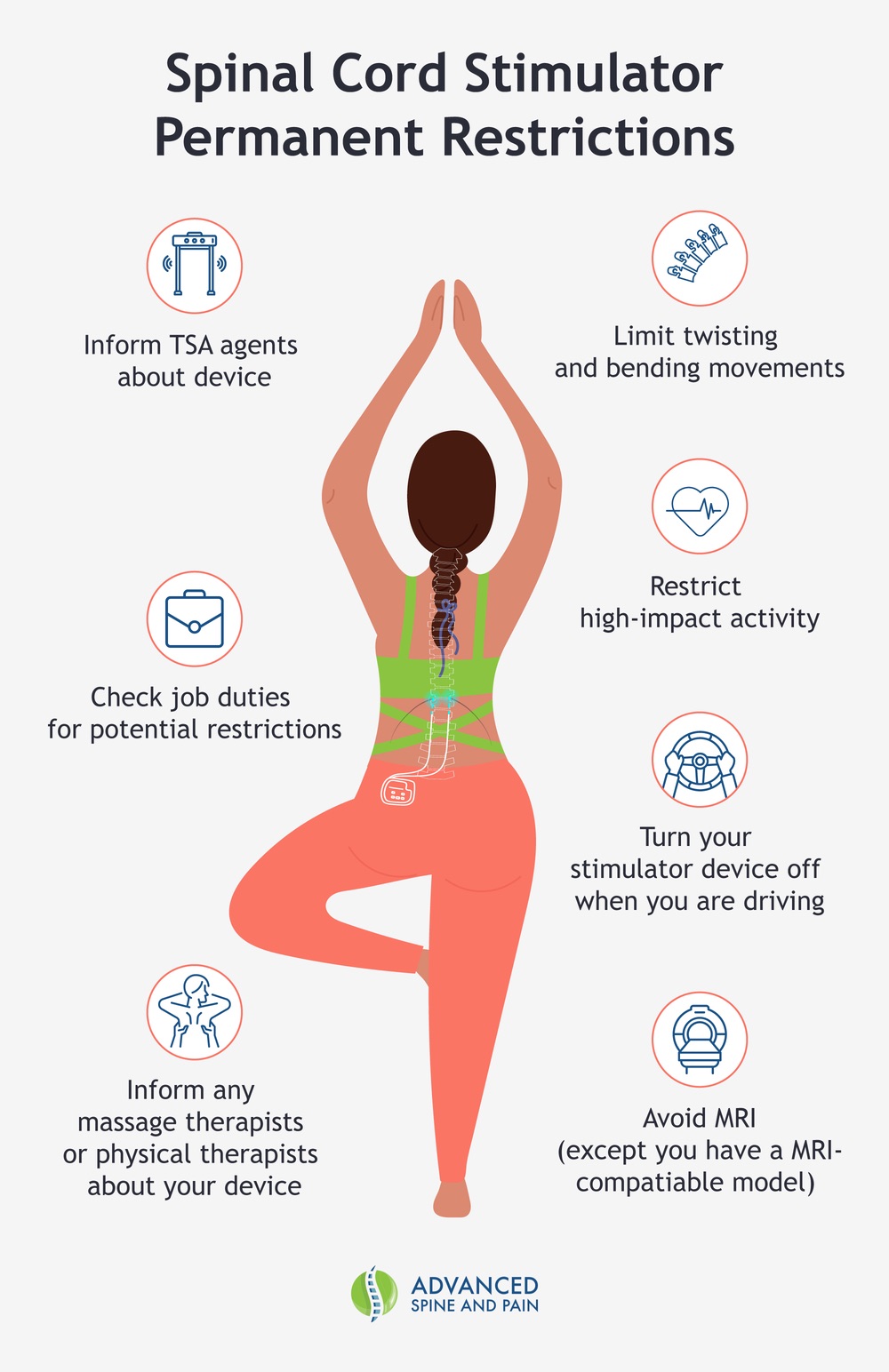... Learn more about any lifestyle restrictions you may experience with a spinal cord stimulator.
A spinal cord stimulator is an implanted device that uses a small electrical current to change how the brain perceives pain signals. This device can be used to treat chronic pain after other conservative treatments have failed.
The permanent stimulator is implanted after an initial spinal cord stimulator trial has successfully provided pain relief for your condition. Before undergoing spinal cord stimulation implantation surgery, it is helpful to understand how it may change your life. Although the device may relieve pain, it may also require some life changes, including permanent restrictions.
The information below explains the spinal cord stimulator's permanent restrictions, side effects, and what to know about living with a spinal cord stimulator.
What are the Permanent Restrictions with a Spinal Cord Stimulator?
People receive a spinal cord stimulator to treat different conditions. Individual circumstances may play a role in the restrictions you may face. Additionally, some restrictions may be temporary during the healing process. However, in general, there are also some permanent restrictions with a spinal cord stimulator, such as those discussed below.
Spinal Cord Stimulator Activity Restrictions
Most people can safely resume low to moderate physical activities after recovering from spinal cord stimulation surgery. This can include exercising. Swimming is also acceptable with permanent implants once your doctor confirms that you have healed from surgery. However, depending on lead placement, your doctor may advise you to avoid twisting or bending in a certain way to avoid damaging or displacing the lead1.
It is best to talk with your doctor before engaging in high-impact activity, such as jogging, sports, and pickleball to ensure it is acceptable.
Are There Any Driving Restrictions after Spinal Cord Stimulation?
Although the device does not interfere with driving, your position while driving may place additional pressure on the leads and cause a stronger sensation delivered by the generator. This is not typically painful but can startle or distract you while driving. If you feel uncomfortable sensations from the stimulator, turn off the device while driving or contact your doctor for reprogramming. If you are a passenger in a car, there is no need to turn the device off.
Spinal Cord Stimulation Work Restrictions
There are typically no specific work restrictions related to a spinal cord stimulator. But it is best to discuss your work duties and environment with your doctor. Depending on your job, there may be certain things you should be aware of or restrictions that may apply.
Airport Security and Spinal Cord Stimulation
According to the TSA2, you can fly with a spinal cord stimulator. However, you should let the TSA agent know you have the device. Usually, metal detectors and airport security systems will detect the device.
If possible, turn off your device before stepping through security.
What to Know About Future Imaging and Spinal Cord Stimulation
You may need specific imaging tests in the future, such as an X-ray, CT scan, or MRI. You can safely have an X-ray and CT scan if you turn off your stimulator.
However, MRIs are not always safe for spinal cord stimulators. Some newer stimulators are compatible with certain MRI machine models, but this will vary on a case-by-case basis. If a device is not MRI compatible, do not go in. It can lead to serious injury. If you have questions, contact your device representative or doctor.
It is also important to inform the imaging technician that you have a spinal cord stimulator before having any type of imaging scan.

What Should I Know About Living With A Spinal Cord Stimulator?
While you are getting used to living with a spinal cord stimulator, you may sense the generator under your skin. This should not be painful, but it may be noticeable. After a short recovery period, most patients get used to it and stop noticing it.
Depending on your settings, you may notice a slight vibration when the stimulation is used. If this becomes bothersome, talk to your doctor about your settings. Discussing this with your physician is also important if you do not get adequate pain relief.
There are a few practical things to remember when you are getting used to living with spinal cord stimulators. For instance, you must use the device remote or control to turn the device on as needed. It may take a little while to get used to taking this with you when you leave the house so you can control the generator.
Also, if you go to a chiropractor, massage therapist, or acupuncturist, tell them you have a spinal cord stimulator. There is no reason to avoid these treatments, but informing a therapist is helpful.
Living with a spinal cord stimulator should provide significant pain relief. This may mean engaging in more activities than you have in a while. If there is an activity you are unsure is safe with a spinal cord stimulator, err on the side of caution and ask your doctor.
Do Different Types of Cord Stimulators Affect Your Life Differently?
There are two different types of4 spinal cord stimulator devices. The different devices do not usually affect permanent restrictions, but they may impact how much effort you put into maintaining the device. Below is more information about each type of stimulator.
Conventional Non-Rechargeable Implantable Pulse Generator
This type of generator involves placing a battery in the soft tissue in your flank area. When the battery wears out, a follow-up surgery is needed to replace it.
This device produces a lower electrical output, so it may be best for someone with pain in just one part of their body. It does not require you to remember to charge the device, which may benefit some people.
Rechargeable Battery Device
A rechargeable battery requires charging on average every few days, depending on each person’s stimulator energy requirements. This type of device can provide more electricity and may be a good choice for someone with higher energy requirements, as determined by your doctor.
Rechargeable battery devices require the user to position the charging unit over the implant for an hour or two, which may be inconvenient for some people.
Your doctor can provide more information and discuss which type of device may be best for you.
Spinal Cord Stimulator Implant Side Effects
After spinal cord stimulator surgery, it is possible to experience side effects. Serious complications are rare5. However, becoming informed about the potential complications of any surgery is vital. During spinal cord stimulator recovery, the following side effects can develop:
- Infection: Infection risk is low but can occur with any surgery.
- Nerve injury: Nerve injury can occur during the insertion, but using fluoroscopy throughout the procedure decreases this risk.
- Bleeding: Bleeding can occur with any surgery. However, the risk of severe complications from bleeding is low with spinal cord stimulation.
- Lead breakage or migration: Over time, the leads may break or move from their location. This risk decreases when following instructions during the recovery period. If you experience lead migration or breakage, you will likely need follow-up surgery to fix the problem.
- Dural puncture: The dura mater, which surrounds the spinal cord, can become punctured if the electrode is inserted too deeply. Guided imaging helps decrease this risk.
Am I a Good Candidate for a Spinal Cord Stimulator?
A spinal cord stimulation implantation can provide relief from chronic pain, including failed back pain syndrome. Most patients try physical therapy and possibly other treatments before considering a spinal cord stimulator procedure. The first step is determining if you are a good candidate for the procedure.
You may be a good candidate for spinal stimulation if you have the following:
- Chronic pain due to conditions such as complex regional pain syndrome, diabetic neuropathy, Failed back surgery, Lumbar Radiculopathy, or spinal stenosis
- Unsuccessful conservative therapy, such as pain medications and injections
- You had a successful spinal cord stimulation trial
Can I Have the Device Removed?
A spinal cord stimulator implant typically relieves pain after a successful trial. However, if there is a problem with the device, you gain an infection, or you decide it does not meet your pain relief needs, you can have your spinal cord stimulator removed.
It may be helpful to talk with your doctor about your pain relief before removing the device. There typically are adjustments that can be made to your settings, which can help.
Summary
Spinal cord stimulation surgery can provide a minimally invasive way to reduce pain. The device can also help improve functioning and overall quality of life. However, a spinal cord stimulator has some restrictions. Becoming educated on these restrictions and learning how they impact your life can help you make an informed decision about spinal stimulation.
Spinal cord stimulation can often help treat pain when other options have failed. If you have any questions or want to schedule a consultation, please contact us today!
References
- Spinal Cord Stimulator. (2022). Cleveland Clinic. https://my.clevelandclinic.org/health/treatments/24237-spinal-cord-stimulator-scs
- External Medical devices | Transportation Security Administration. (n.d.). https://www.tsa.gov/travel/security-screening/whatcanibring/items/external-medical-deviceshttps://www.tsa.gov/travel/security-screening/whatcanibring/items/external-medical-devices#:~:text=Checked%20Bags:%20Yes%20(Special%20Instructions,advanced%20imaging%20technology%20for%20screening.
- Sivanesan, E. Spinal Cord Stimulator. (n.d.). John Hopkins Medicine. https://www.hopkinsmedicine.org/health/treatment-tests-and-therapies/treating-pain-with-spinal-cord-stimulators
- Sivanesan, E. Spinal Cord Stimulator. (n.d.). John Hopkins Medicine. https://www.hopkinsmedicine.org/health/treatment-tests-and-therapies/treating-pain-with-spinal-cord-stimulators
- Garcia K, Wray JK, Kumar S. Spinal Cord Stimulation. [Updated 2023 Apr 24]. In: StatPearls [Internet]. Treasure Island (FL): StatPearls Publishing; 2024 Jan. https://www.ncbi.nlm.nih.gov/books/NBK553154/
- Log in to post comments

